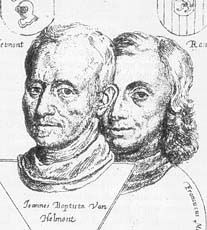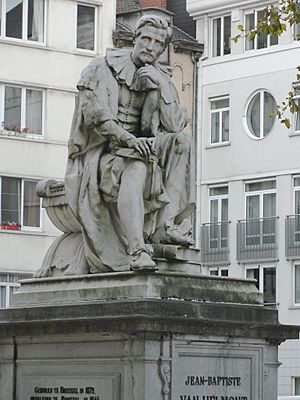Jan Baptist van Helmont facts for kids
Quick facts for kids
Jan Baptist van Helmont
|
|
|---|---|

Jan Baptist van Helmont (left) and his son Franciscus-Mercurius from the Ortus medicinae (1648)
|
|
| Born | 12 January 1580 Brussels, Spanish Netherlands (present-day Belgium)
|
| Died | 30 December 1644 (aged 64) Vilvoorde, Spanish Netherlands (present-day Flemish Brabant, Belgium)
|
| Education | University of Leuven |
| Known for | Pneumatic chemistry |
| Scientific career | |
| Fields | Chemistry, physiology, medicine |
| Academic advisors | Martin Delrio |
| Influences | Paracelsus |
| Influenced | Franciscus Sylvius |
Jan Baptist van Helmont (born January 12, 1580 – died December 30, 1644) was an important scientist from what is now Belgium. He was a chemist, a physiologist (someone who studies how living things work), and a physician.
Van Helmont lived during a time when science was changing. He is often called the "founder of pneumatic chemistry", which is the study of gases. He is also remembered for his ideas about how life might start on its own (spontaneous generation). He did a famous experiment with a willow tree and was the first to use the word "gas" in science. He got the word "gas" from the Greek word chaos.
Contents
Who Was Jan Baptist van Helmont?
His Early Life and Education
Jan Baptist van Helmont was the youngest of five children. His father, Christiaen van Helmont, was a public prosecutor and a council member in Brussels. Jan Baptist studied at the University of Leuven. He tried many different sciences but didn't find one that truly satisfied him until he turned to medicine.
He took a break from his studies and traveled for a few years. He visited countries like Switzerland, Italy, France, Germany, and England.
Becoming a Doctor and Family Life
After his travels, van Helmont returned home and earned his medical degree in 1599. He worked as a doctor in Antwerp during a big plague in 1605. He even wrote a book about the plague called De Peste.
In 1609, he received his final doctoral degree in medicine. That same year, he married Margaret van Ranst, who came from a rich noble family. They lived in Vilvoorde, near Brussels, and had six or seven children. Because his wife had inherited a lot of money, van Helmont was able to stop working as a doctor early. This allowed him to focus on his chemistry experiments until he passed away in 1644.
A Pioneer in Chemistry

Jan Baptist van Helmont is known as the founder of pneumatic chemistry. This is because he was the first to understand that there are different types of gases, not just regular air. He also invented the word "gas."
He realized that the "gas sylvestre" (carbon dioxide) released when charcoal burns was the same gas produced by fermenting grape juice. This gas can make the air in caves unsafe to breathe. Van Helmont believed that air and water were the two most basic elements. He did not think fire was an element, and he believed earth could be turned into water.
Experimentation and New Ideas
Van Helmont was influenced by Paracelsus, another famous alchemist and mystic. However, van Helmont also believed in the "new learning" that focused on experiments. This new way of thinking was being used by scientists like William Harvey and Galileo Galilei.
Van Helmont was a careful observer of nature. His experiments showed that he understood the idea of conservation of mass. This means that matter cannot be created or destroyed. He was one of the first scientists to try and figure out how plants gain weight as they grow.
The Willow Tree Experiment
One of van Helmont's most famous experiments involved a willow tree. This study is considered one of the first careful measurements of how plants grow. He planted a small willow tree and measured the amount of soil it was in. He also weighed the tree and carefully measured all the water he added to it.
After five years, the tree had grown a lot, gaining about 164 pounds (74 kg). The amount of soil, however, had barely changed, losing only 57 grams. From this, van Helmont concluded that the tree's weight gain came almost entirely from the water he had given it. This was a big step in understanding plant nutrition.
His Beliefs and Writings
Van Helmont was a faithful Catholic. However, some of his writings caused suspicion from the Church. His works were later collected and published by his son, Franciscus Mercurius van Helmont, in a book called Ortus medicinae (meaning "The Origin of Medicine") in 1648.
Ideas on Digestion
Van Helmont wrote a lot about how our bodies digest food. He looked at older ideas, like the belief that digestion happened because of the body's internal heat. But he asked, if that were true, how could cold-blooded animals digest food?
He believed that digestion was helped by a special chemical, or "ferment," inside the body, especially in the stomach. Some scientists today think his idea was very similar to our modern understanding of enzymes. Enzymes are special proteins that help speed up chemical reactions in the body. Van Helmont described six different steps in the digestion process.
Disputed Portrait
In 2003, a historian named Lisa Jardine suggested that a portrait at the Natural History Museum, London, which was thought to be of John Ray, might actually be Robert Hooke. However, later research by William Jensen and Andreas Pechtl proved that the portrait actually shows Jan Baptist van Helmont.
See also
 In Spanish: Jan Baptista van Helmont para niños
In Spanish: Jan Baptista van Helmont para niños




